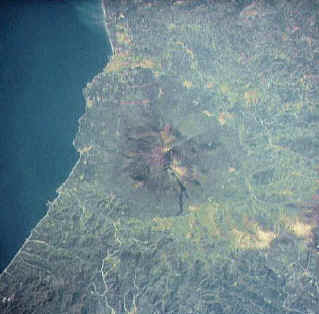
|
|
| Sicily (formerly Sicania and Tricania) is the largest (25,460 sq km) and most important island in the Mediterranean, where it occupies a central position. Around it are a number of archipelagos which administratively belong to the island: the Lipari or Aeolian island, Ustica, the Egadi and Pantelleria, and the Pelagie. Sicily is a region of volcanoes. The highest is Etna (3,370 m), a solitary relief near Catania. Other volcanoes have formed some of the minor island: all the Lipari islands, Ustica, Pantelleria. Some of these are still active (Stromboli and Vulcano) or dormant, while other have been extinct since time immemorial. In addition to Etna’s imposing volcanic cone, Sicily has four mountain groups. The first (the Sicilians Appennines) stretches along the north coast, from the Strait of Messina to the Torto River, as a continuation of the Calabrian Appennines. It is divided into three sections: the Peloritani, the Nebrodi (or Caronie) and the Madonie, and its highest peaks rise to about 2,000 m. The second group encircles the western part of Sicily, to the west of the Torto and Platani rivers. The third mountain group forms the heart of the island, and overlook the African Sea to the south-west; its most characteristic part is often referred to as the “sulphur-bearing upland”. |
|

View of Etna from the satellite |
The south-east corner of Sicily is mostly characterized by a plateau (Hyblaean Mountains). The island has little flat land. The largest stretch, 430 sq km, is the Catania Plain, Iying between Etna and the mountains of the province of Syracuse. Other flat areas lie in the province of Trapani, near Marsala, Mazara and Castelvetrano, whose fertile red soil nurtures the world-famous grapevines. Similar features are found in the areas surrounding Scoglitti and Vittoria, in southern Sicily. The major rivers are the Salso (or South Imera) and the Platani, but they are almost dry in summer. The climate is typically Mediterranean along the coasts, with hot but not torrid summers, mild and short winters, and moderate rainfall (from October to March). The annual average of clear days is 98 in Palermo; 110 in Messina; 130 in Taormina; 133 in Syracuse. The annual average temperature along the coast is between 17° C and 18.7° C, July being the hottest month. The typical evergreen Mediterranean scrub vegetation is widespread. There are still traces of the oak-woods which must have covered the lower mountains in ancient times, as well as of the beech-woods which form the upper belt of the Nebrodi and Madonie woods. |
| Among the cultivated species is the ash, flourishing on the slopes of the north coast. The olive-tree and the vine were introduced in ancient times (from the Near East), as were the almond-tree, the pistachio, the pomegranate and the hazel (imported from Campania). Other species imported from the East include the carob, the sumac, the palm-tree (though its fruit rarely ripens), the mulberry, the lemon tree and the bitter orange. The sweet orange (Portogallo) was brought from China by the Portuguese only in the 16C, while the tangerine was imported from Madura (Sonda) about two centuries ago. The holm oak is especially widespread at altitudes between 300 m and 600 m. Cork-woods are also present. |
Sicilian Citruses |